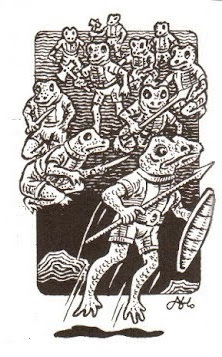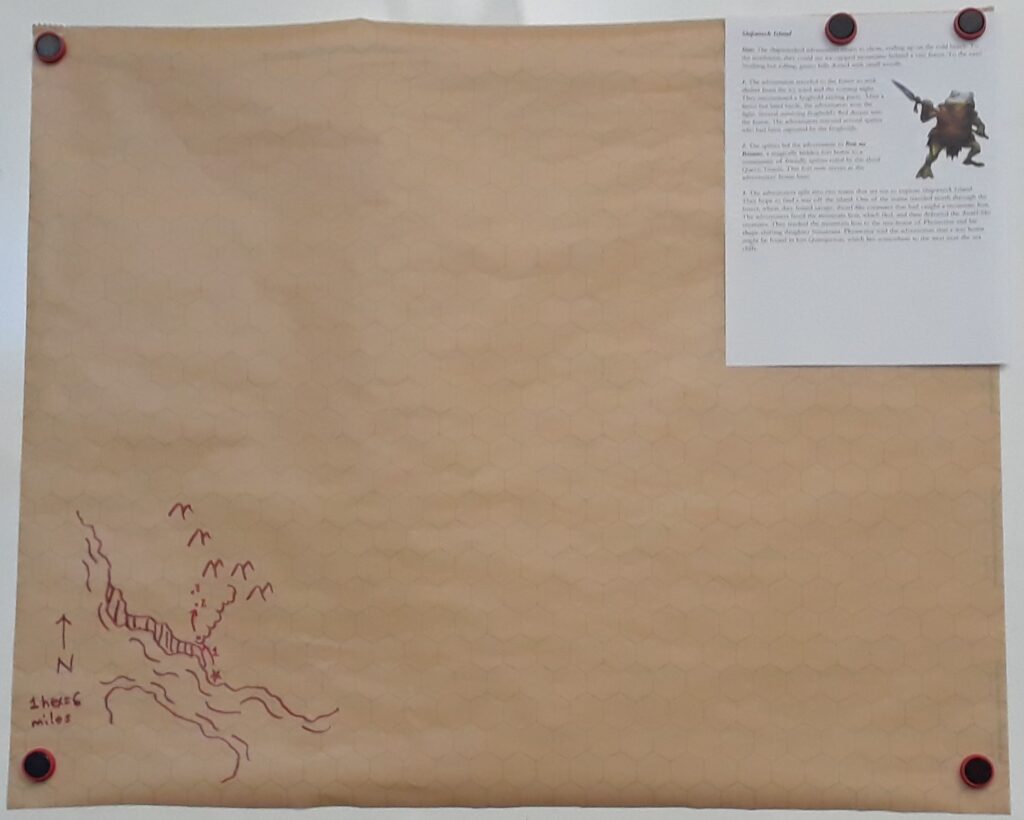Bullywugs for DCC/MCC
More than two centuries ago, stars fell from the night sky, bringing with them the Ancient Ones, conquerors who commanded terrible technologies. Wars raged for decades. Cities fell. Alien energies burned forests and reduced grasslands to dust. Little by little, Oerth’s defenders turned back the blood-dimmed tide. The stellar invader’s defenses failed, and they either retreated back to the stars or vanished into the Nether Gloom.
A few weeks ago, I started running a sporadic DCC/MCC mashup set in a post-apocalyptic World of Greyhawk. The funnel adventure took place in the Hommlet on a dark, stormy night during which a mob of bullywugs attacked the village. Below are the stats for the bullywugs and two mutant forms of bullywug. Enjoy!
Bullywug
Bullywugs, vicious humanoid frog-men, primitive and violent, live in wetlands and rainforests, venturing forth to raid and kill. These creatures are given to religious mania, and charismatic leaders find bullywugs useful servants. This is especially true among followers of Wastri the Hopping Prophet.
Bullywugs speak their own language. Leaders often speak one or two other languages as well. It is rumored that perverse matings of bullywugs and humans produce degenerate humans afflicted by froggish features and behaviors.
#APP 10d8 (20% in lair); Init +1; Atk as weapon +1 melee or tongue spike +2 ranged (1d4 plus poison); AC 11 + armor; HD 1d8+1; MV 20 ft., 20 ft. climb, 30 ft. jump, 20 ft. swim; Act 1d20; SP camouflage, jump, tongue spike; SV Fort +2, Ref +2; Will -1; AL C.
Camouflage: Skin coloration varies from light to dark shades of gray, green, or brown. If motionless, a bullywug is 75% like to be unseen.
Jump: A bullywug’s jump clears a vertical distance equal to half the horizontal distance. With a standing jump, a bullywug can leap 15 feet straight up.
Tongue Spike: Range 20 ft. with no range modifers. Fort SV DC 10 or paralyzed for 1d5 melee rounds.
Armor & Weapons: Bullywugs seldom wear armor heavier than leather or use shields. They prefer spears.
For every 10 bullywugs: 1 bullywug with 9 hit points.
For every 10 bullywugs: A cumulative 10% chance of a tribal shaman with 3+3 hit dice who has the abilities of a 3rd-level Cleric.
For every 20 bullywugs: 1d5-1 tad-things and 1d3-1 bull bullywug.
For every 30 bullwugs: 1 leader with 2+2 HD and at least 10 hit points.
If 60 or more bullywugs: 1 great chief with 4+4 HD and at least 16 hit points. A great chief has an effective STR bonus of +2.
Bullywug, Bull
A bull bullywug (sometimes called bullywug ogres) grows to greater size and strength than normal for even the healthiest bullywugs. Normal bullywugs fear these mutant bullywugs, and bullywug chiefs reward bulls with special privileges. Bulls have all the abilities of normal bullywugs.
#APP 1d3-1 per 20 bullywugs; Init +0; Atk as weapon +5 melee (+3 damage) or tongue spike +3 ranged (1d6 plus poison); AC 12 + armor; HD 4d10+8; MV 30 ft., 20 ft. climb, 30 ft. jump, 20 ft. swim; Act 1d20; SP camouflage, jump, tongue spike; SV Fort +4, Ref +2; Will +2; AL C.
Bullywug, Tad-Thing
Tad-things are not immature bullywugs as many assume. They are a strange bullywug mutation. A tad-thing has a ball-like body roughly the size of a grapefruit. A half dozen or so sinuous tentacles grow from the body, which is split by a sphincter-like mouth full of sharp teeth. Bullywug raiders often carry buckets holding water and 1d3 tad-things. Bullywugs throw the tad-things as a ranged weapon with range increments of 10/20/30.
#APP 1d5-1 per 20 bullywugs; Init +2; Atk tentacles +1 melee (1d4 plus blood drain); AC 12; HD 2d6; MV 10 ft., 10 ft. climb, 30 ft. swim; Act 1d20; SP blood drain (automatic 1d4 damage after bite), tentacles (10-ft. reach), zombification; SV Fort +0, Ref +2; Will +0; AL C.
Zombification: A humanoid creature killed by a tad-thing rises as a 1-HD zombie in 1d5 rounds (DCC 431).





